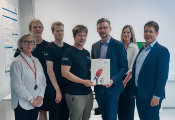Breakthrough Discovery in Magnetic Materials Could Unlock New Quantum States
University of Oxford, December 05, 2024 -- In a study published today in Nature Communications, researchers from the Quantum Magnetism group in the Department of Physics have developed an innovative approach to synthesise and study rare-earth magnetic materials. This achievement marks a significant advancement in understanding quantum magnetic states, potentially bringing the field closer to realising elusive quantum spin liquids.
The team successfully created and analysed a novel magnetic oxide called Na₂PrO₃, featuring rare-earth Praseodymium (Pr) ions with entangled magnetic states – a property resulting from the tight link between electrons' spin and orbital motion, known as spin-orbit coupling. By synthesising Na₂PrO₃ in two distinct crystal structures, or polymorphs, the researchers uncovered a unique foundation for studying quantum magnetic interactions. One polymorph forms a two-dimensional honeycomb arrangement, while the other features a three-dimensional structure known as a hyperhoneycomb. The hyperhoneycomb arrangement is especially notable for its three-dimensional connectivity, which supports complex interactions theorised to stabilise quantum spin liquid states, where traditional magnetic order dissolves into an entangled quantum state.
Experiments on the hyperhoneycomb Na₂PrO₃ revealed an unexpected magnetic ground state with non-traditional properties, showing non-collinear magnetic order (with magnetic moments aligned along different directions for diferent bonds in the lattice) and unique excitation spectrum. This is particularly intriguing because conventional magnetism models cannot account for these findings, suggesting that a new form of quantum interaction between magnetic moments – known as a ‘quantum compass model’ – is at work. This discovery opens up new avenues to explore exotic magnetic phases, including much anticipated quantum spin liquid phases.
Growing these materials for the first time in single crystal form has been a real tour-de-force in materials synthesis, requiring a deep understanding of the role of temperature and additives for the formation and stability of the three different structural polymorphs, and performing all synthesis in inert atmosphere. Postdoctoral researcher Dr Ryutaro Okuma is the paper’s lead author and he explains: ‘Despite the simple chemical formula, the preparative chemistry of Na2PrO3 has been far more complex than I initially thought. The synthesis has been very challenging – but very rewarding at the same time. It enabled us to discover a new type of unconventional magnetic ground state on the hyperhoneycomb lattice, a lattice that is very rare in nature, and not realised before for rare-earth ions.’
Graduate student Kylie MacFarquharson, who performed heat capacity and torque magnetometry experiments, adds, ‘It was very exciting to observe first evidence for unconventional magnetism from single-crystal angle-dependent torque measurements and from exploring the scaling behaviours as a function of applied magnetic field.’
Additional insights into the magnetic properties of Na₂PrO₃ were gained through neutron diffraction and inelastic neutron scattering, conducted in collaboration with scientists at the ISIS pulsed neutron source and UCL. These experiments helped to reveal the unconventional magnetic order and the fundamental quantum dynamics within the material, providing new data supporting the potential for rare-earth compounds to reveal previously unobserved quantum states.
‘Exploring experimentally new platforms that realise strongly-frustrated quantum spin models offers the opportunity to discover new types of magnetic ground states, as we have found here. The understanding and insights that come from such research could potentially bring us closer to realising experimentally more exotic quantum phases, such as quantum spin liquids,’ comments Professor Radu Coldea, who supervised the project.
This breakthrough, supported by the European Research Council (ERC) and the Engineering and Physical Sciences Research Council (EPSRC), signifies a major step forward in the quest for new quantum materials.




































